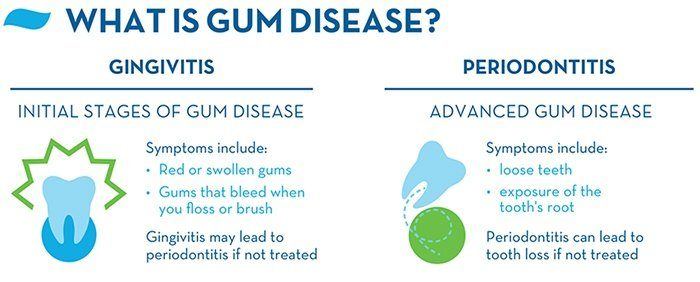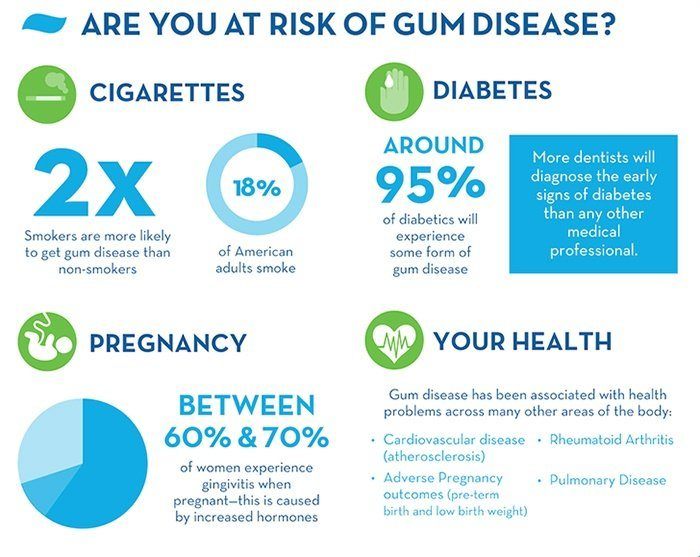- Home
- Oral Care Tips
- Solutions
- Gum Health
Gum Disease: Symptoms, Causes and Treatments
What is Gum Disease?
Gum disease, also known as periodontal disease, is a bacterial infection involving the gums and sometimes the bone that surrounds a tooth. Gum diseases can affect one tooth or many teeth, and they range from gum irritation (gingivitis) to severe infection (periodontitis). It is important to pay special attention to your gums because if you're not taking care of your gums, you're not taking care of your mouth.

Gum Disease Stages
Below you’ll find details about common and serious gum diseases:
- Gingivitis:Gingivitis is the earliest and mildest form of the gum diseases, and it is characterized by redness and swelling of the gums. Unlike more serious gum diseases, gingivitis rarely requires surgical treatment and it can usually be managed with a professional dental cleaning followed by attention to a regular oral care routine.
- Chronic Periodontitis: Chronic periodontitis is the most common of the full-fledged gum diseases. The main symptoms include receding gums and the formation of pockets between the gums and the teeth. Chronic periodontitis occurs more often in adults than in children; a majority of individuals with this condition are older than 35 years.
- Aggressive Periodontitis: In general, gum diseases are rare in children, but some children and adults develop aggressive periodontitis, even if they are otherwise healthy. Aggressive periodontitis can occur in children as young as 3 years, and sometimes even younger. By age 20, individuals with especially aggressive gum diseases can lose teeth. Gum diseases that are subtypes of aggressive periodontitis include a condition in adolescents (sometimes referred to as localized juvenile periodontitis) that involves an over-colonization of bacteria. Another less common condition, sometimes referred to as prepubertal periodontitis, affects young children shortly after their primary teeth appear. Children with gum diseases might not complain of tooth pain, but common symptoms of gum diseases in children include excess plaque; red, swollen, or bleeding gums; and the presence of pus and unpleasant breath.
- Necrotizing Periodontitis: Of all the gum diseases, this type may be the most severe. Also known as acute necrotizing ulcerative gingivitis, the condition can destroy tissues, ligaments, and bones in the mouth. Necrotizing periodontitis is most common in people who smoke or in individuals who are malnourished or who have conditions that compromise their immune systems, such as HIV/AIDS.
Gingivitis vs. Periodontitis
The terms “gingivitis,” “periodontitis,” and “periodontal disease” are often used interchangeably, but they actually have three distinct meanings. Each of these stages have an impact on the oral health of America though, with 24 million Americans having lost 6+ teeth due to decay or gum disease and 12 million Americans have lost all of their teeth due to decay or gum disease.

- Gingivitis refers to inflammation of the gums due to an excess of plaque on the teeth. Signs of gingivitis include red, swollen gums, or gums that bleed easily when you brush your teeth. It is the mildest form of gum disease and since it is so common, you may not notice the symptoms if you have them.
- Periodontitis refers to advanced periodontal disease. In periodontitis, the gum tissue pulls away from the teeth, creating pockets where additional bacteria can build up and cause an infection. Signs of possible periodontitis include continued red, swollen, or bleeding gums, pain when chewing, poor tooth alignment, receding gums or pockets between the teeth and gums, sores on the inside of the mouth, and loose or sensitive teeth. Periodontitis can cause lasting damage to your teeth and the bones that support them and is the leading cause of tooth loss. Because periodontitis is a severe form of gum disease, you can’t treat it on your own at home. If you experience any of the signs of periodontal disease below, be sure to see your dentist and hygienist as soon as possible.
- Periodontal disease is a more generalized term for gum disease and therefore will include both gingivitis and periodontitis. Do you have gingivitis or periodontitis?
If you aren’t sure, here are some tips for how to tell the difference.
- Age: Periodontitis is rare in teenagers, but they can develop gingivitis.
- Pain: Pain when chewing can be a sign that your periodontal disease has progressed from gingivitis to periodontitis.
- Tooth Condition: If you have gingivitis, your teeth should be firmly in place, although your gums may be irritated, red, and swollen. If a tooth or teeth are loose, it is more likely that you have periodontitis.
- Breath: If your gingivitis has progressed to periodontitis, you may notice that you have persistent unpleasant breath due to the presence of excess bacteria in your mouth.
Signs and Symptoms of Gum Disease
Gum disease ranges in severity from redness and swelling of the gums (gingivitis) to a more severe infection (periodontitis). Gum disease symptoms are not always obvious until gingivitis has progressed to periodontitis. Gingivitis is generally defined as an inflammation around a tooth, which occurs when plaque and tartar build up on the teeth. Poor oral hygiene is the main cause of periodontitis, and the condition is most likely to develop in adults aged 30 years and older. Gum disease symptoms can include:
- Pain: Pain or tenderness in your gums or pain in your teeth.
- Swelling: Swollen gums or gums that look red or purple can be gum disease symptoms. Healthy Gums should look firm and pink.
- Taste and Smell: Persistent bad breath and an unpleasant taste in your mouth are possible gum disease symptoms.
- Space: Development of spaces between your teeth, or a change in the way your teeth come together when you close your mouth. In addition, receding gums can be among the early gum disease symptoms.
- Bleeding: Gum disease symptoms to watch for include bleeding gums when you brush or floss.
- Loose Teeth: Gums that pull away from the teeth, creating pockets where additional bacteria can build up. If you have symptoms of gum disease, your dentist will examine your teeth and gums to confirm the diagnosis. If symptoms of gum disease are caught early, the treatment may be as simple as a thorough dental cleaning and a revision of your at-home oral care routine.
Gum Disease Causes
Many gum disease symptoms don’t appear until the disease is well-established, so it is important to know some of the risk factors for gum disease. Identifying risk factors and paying attention to your oral hygiene can help you spot gum disease symptoms early so you can see your dentist as soon as possible. One of the main causes of gum disease is a build-up of bacteria. Harmful bacteria build up on the teeth and around the gum line each day. If they aren’t removed by a regular oral care routine of brushing and flossing, they can cause the gum inflammation and gingivitis. Left untreated, it can progress to periodontitis, which is more serious.

Risk factors associated with gum disease include:
- Smoking: Many studies have shown that smoking or using other tobacco products significantly increases your risk for gum disease. If you smoke or use other tobacco products and you notice some gum disease symptoms, quit or cut back on tobacco use and see a dentist as soon as possible.
- Genetics: If you have family members with gum disease symptoms or a history of gum disease, pay extra attention to your oral care routine and visit a dentist regularly for a professional cleaning and checkup.
- Hormones: Although more research is needed, some studies have suggested that hormones associated with puberty, pregnancy, and menopause can increase women’s risk for gum disease. Puberty, pregnancy, and menopause aren’t exactly gum disease causes, but women should be sure to pay extra attention to their oral care during these times.
- Medical Conditions: Diabetes is associated with an increased risk for periodontal disease. In addition, chemotherapy or other treatments for illnesses such as cancer or AIDS can increase your risk for periodontal disease.
- Stress: Studies have shown that stress can make it harder for the body to fight infections, and that includes periodontal disease.
- Medications: Medications that dry up saliva can increase your risk of periodontal disease. Saliva helps protect against periodontal disease by helping wash plaque and bacteria from the teeth.
- Family History: Some people are simply more susceptible to periodontal disease because of their heredity. If many of your relatives have had periodontal disease, you may be at increased risk.
Gum Disease Treatments
The treatment of gum diseases may be surgical or non-surgical, depending on the severity of the disease and the patient’s preferences.
- Non-surgical: Non-surgical options for the treatment of gum diseases include antibiotics and a non-surgical deep-cleaning procedure called tooth scaling and root planing that removes tartar and plaque from below the gum line. Some limited research suggests that lasers can be used in addition to tooth scaling and root planing to make the procedure more effective, but there is not enough evidence to recommend a specific wavelength or type of laser for the treatment of gum diseases.
- Surgical: Surgical treatments for gum diseases include procedures to reduce pockets that have formed at the gum line, procedures to regenerate lost bone and tissue, procedures to remove excess gum tissue to expose more of the tooth surface, and procedures to graft soft tissue onto the gums to cover exposed bone and prevent tooth loss. The successful treatment of any gum diseases depends in part on getting regular dental checkups and following a complete oral hygiene routine. And if you smoke, quit. Tobacco use can interfere with the recovery from gum diseases and increase the risk of recurrence.
Quick Facts About Gum Disease
Since there appears to be some confusion about the importance of treating gum disease, The American Academy of Periodontology (AAP) has published the following facts about gum disease.
- Bleeding gums are a big deal. Bleeding gums are an important sign of gum disease and should be taken seriously. If you notice this symptom, schedule an appointment with a dental professional.
- Flossing every day is important. Diligent oral hygiene, which includes flossing every day, helps treat and prevent gingivitis as part of a comprehensive dental plan.
- If visiting a periodontist is scary for you. If you are diagnosed with advanced gum disease, you may want to consult with a periodontist, a dentist who specializes in gum disease. They are equipped with the latest treatments and technologies to treat advanced gum disease.
- Dental Implants Can Replace Teeth Lost to Gum Disease. Advanced gum disease is one of the leading causes of tooth loss in adults. However, dental implants can effectively replace teeth that are lost due to gum disease.
- Poor oral hygiene is NOT the only cause of gum disease. While poor oral hygiene often causes gum disease, there are other factors that increase your risk. The use of tobacco, poor diet, stress, bacteria below the gum line, and genetics may also play a role in gum health. As with any disease diagnosis, you should take gum disease seriously. Speak with your dental professional and follow their advice to help improve your overall oral health and the health of your gums.
How To Prevent Gum Disease
While you may know that poor oral hygiene often causes gum disease, you may not know how to stop gingivitis, the earliest form of gum disease. If caught early, it is fairly simple to help treat and prevent it by getting your oral hygiene routine back on track. Did you know that one out of two American adults suffer from gingivitis? Learning how to stop gingivitis and sharing this information can help prevent the prevalence of gum disease in this country. Here are a few simple ways to help stop gingivitis.
- Brush Twice a Day: Just like your dental professional recommends, brushing twice a day can go a long way to help stop gingivitis. You may want to consider a toothpaste like Crest Gum Detoxify Deep Clean that reaches more areas in your mouth to better clean and along your gum line as it treats sensitivity at the source. Or try brushing with Crest Gum Detoxify Deep Clean, it can gently neutralize the plaque bacteria around the gum line, an area that is crucial to the health of your mouth.
- Floss Every Day: Flossing can help stop gingivitis progression by removing plaque and food particles.
- Give Up Tobacco: Since smoking may be responsible for nearly 75 percent of periodontal diseases among adults, quitting is a great way to help stop gingivitis. The use of tobacco products causes damage to your gum tissue, which can lead to receding gums and increased risk for gum disease.
- Regular Dental Checkups: Twice yearly visits to your dental professional for checkups and cleanings should be part of your plan to treat gum disease. Use this opportunity to talk to your dental professional about products to help treat gum disease.
- Healthy Living: In addition to following a regular oral care routine, you can help treat gum disease by eating a healthy diet with plenty of fruits, vegetables, and whole grains. Other elements of a healthy lifestyle, such as not smoking and getting regular exercise, are also important to help prevent gum disease.
Help stop gum disease before it starts by following a regular oral care routine. This regimen should provide comprehensive tooth and gum care to help prevent and treat gingivitis, an early form of gum disease. An anti-gingivitis toothpaste like Crest Gum Detoxify contain an active ingredient that neutralizes plaque bacteria around the gum line to give you clinically proven healthier gums. A mouthwash like Crest Pro-Health Multi-Protection helps keep your whole mouth healthier and keep it fresh while reducing bleeding gums.
[ ]
]
Discover More
The Best Mouthwash for Gingivitis and Gum Disease
